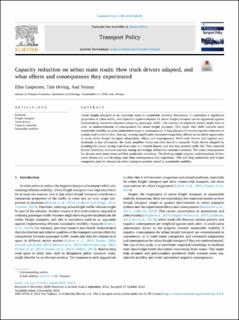| dc.contributor.author | Caspersen, Elise | |
| dc.contributor.author | Ørving, Tale | |
| dc.contributor.author | Tennøy, Aud | |
| dc.coverage.spatial | Norway, Oslo | en_US |
| dc.date.accessioned | 2023-06-15T12:06:01Z | |
| dc.date.available | 2023-06-15T12:06:01Z | |
| dc.date.created | 2022-11-04T09:11:30Z | |
| dc.date.issued | 2022-11-03 | |
| dc.identifier.citation | Transport Policy. 2022, 130 68-83. | en_US |
| dc.identifier.issn | 0967-070X | |
| dc.identifier.uri | https://hdl.handle.net/11250/3071562 | |
| dc.description | Elise Caspersen, Tale Ørving, Aud Tennøy, Capacity reduction on urban main roads: How truck drivers adapted, and what effects and consequences they experienced, Transport Policy, Volume 130, 2023, Pages 68-83, ISSN 0967-070X, https://doi.org/10.1016/j.tranpol.2022.10.016. (https://www.sciencedirect.com/science/article/pii/S0967070X22003018) | en_US |
| dc.description.abstract | Urban freight transport is an important issue in sustainable mobility discussions. It constitutes a significant proportion of urban traffic, and expected negative impacts for urban freight transport can be arguments against implementing restrictive measures targeting passenger traffic. The scarcity of empirical studies might lead to over- or underestimation of consequences for urban freight transport. This might slow shifts towards more sustainable mobility or cause unintended negative consequences. A long-planned 14-month capacity reduction in a main road tunnel in Oslo, Norway, causing significantly increased congestion, offered an excellent opportunity to study urban freight transport adaptations, effects and consequences. With truck drivers and logistics professionals as key informants, the study amplifies voices not often heard in research. Truck drivers adapted by avoiding the tunnel during rush hours only to a limited degree, and less than general traffic did. They reported limited flexibility, as routes and trip timing are strongly defined by customer contracts. The wider consequences for drivers were more stress and less predictable workdays. The findings might improve understandings of how truck drivers can and do adapt, and what consequences they experience. This will help authorities and freight companies plan for changes in urban transport systems aimed at sustainable mobility. | en_US |
| dc.language.iso | eng | en_US |
| dc.publisher | Elsevier | en_US |
| dc.rights | Navngivelse 4.0 Internasjonal | * |
| dc.rights.uri | http://creativecommons.org/licenses/by/4.0/deed.no | * |
| dc.subject | Freight transport | en_US |
| dc.subject | Truck drivers | en_US |
| dc.subject | Capacity reduction | en_US |
| dc.subject | Sustainable mobility | en_US |
| dc.title | Capacity reduction on urban main roads: How truck drivers adapted, and what effects and consequences they experienced | en_US |
| dc.title.alternative | Capacity reduction on urban main roads: How truck drivers adapted, and what effects and consequences they experienced | en_US |
| dc.type | Journal article | en_US |
| dc.type | Peer reviewed | en_US |
| dc.rights.holder | © 2022 The Authors. Published by Elsevier Ltd. | en_US |
| dc.description.version | publishedVersion | en_US |
| cristin.ispublished | true | |
| cristin.fulltext | original | |
| cristin.qualitycode | 1 | |
| dc.identifier.doi | 10.1016/j.tranpol.2022.10.016 | |
| dc.identifier.cristin | 2069010 | |
| dc.source.journal | Transport Policy | en_US |
| dc.source.volume | 130 | en_US |
| dc.source.issue | Januar 2023 | en_US |
| dc.source.pagenumber | 68-83 | en_US |
| dc.relation.project | Norges forskningsråd: 257152 | en_US |

